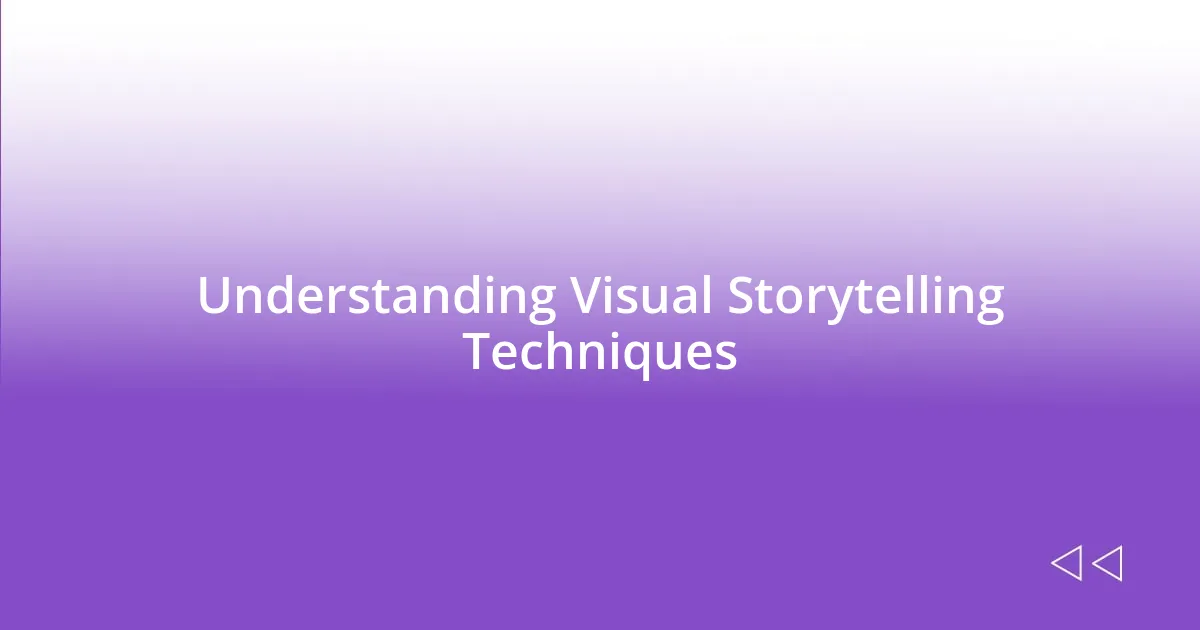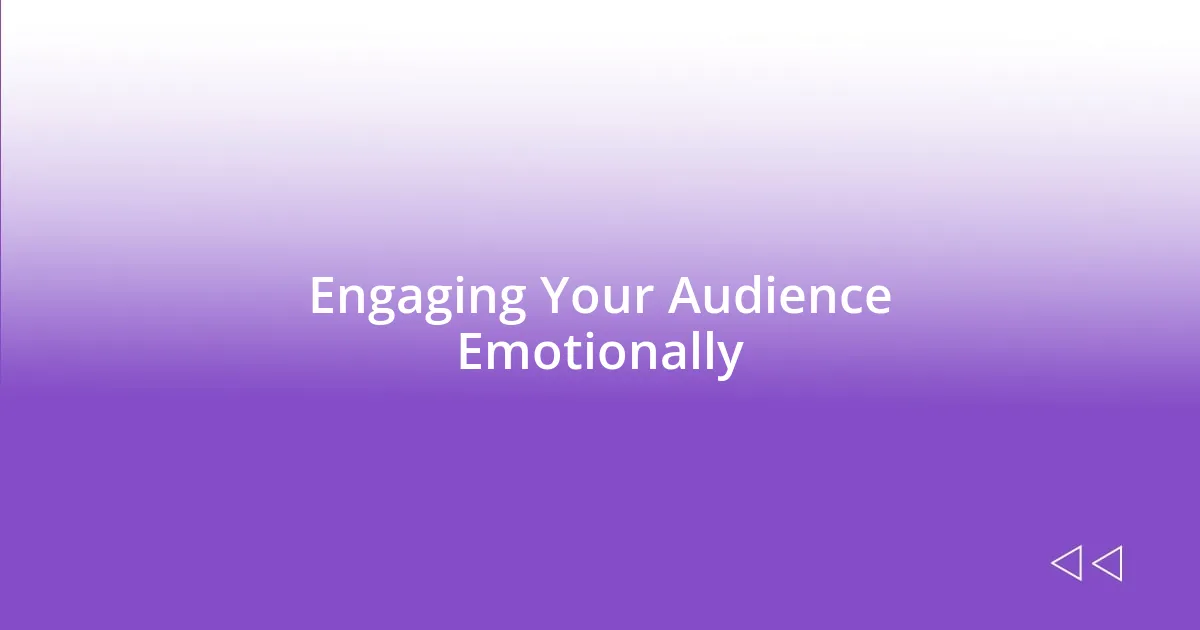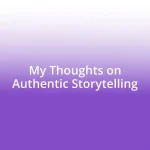Key takeaways:
- The power of composition and color significantly influences the emotions and narratives conveyed in visual storytelling.
- Engaging the audience emotionally requires authenticity, vulnerability, and an awareness of pacing in narratives.
- Utilizing different mediums, such as combining visuals with sound, can enhance storytelling depth and emotional connection.
- Feedback is crucial in the creative process, helping to uncover new perspectives and strengthen narratives.

Understanding Visual Storytelling Techniques
One key visual storytelling technique that stands out to me is the power of composition. I recall a moment in a workshop where we experimented with framing scenes. I arranged my subject slightly off-center, allowing more negative space. The instructor pointed out how this subtle shift actually evoked a feeling of isolation and contemplation. Isn’t it amazing how a simple change can influence the story you’re telling?
Color is another critical element that I believe deserves our attention. During one session, we learned how different colors can trigger emotions. For instance, warm tones can create a sense of warmth and comfort, while cool tones might evoke sadness or distance. I remember capturing a scene bathed in golden light, and it instantly felt joyful. Does your choice of color not shape the entire mood of your visuals?
Then there’s the importance of narrative flow. I once created a visual story that began with vibrant activity but transitioned to stillness. The contrast was profound, almost like a dramatic pause in music. Reflecting on this, I wonder how often storytelling in our visuals mirrors the ebb and flow of life itself, balancing chaos with moments of peace.

Importance of Visual Elements
The significance of visual elements cannot be overstated. I recall a workshop exercise where we had to rely solely on the arrangement of objects to narrate a story. It was enlightening to witness how the placement of a single item could entirely shift the viewer’s perception. Suddenly, a seemingly mundane scene transformed into a tale of longing just by repositioning a chair. It struck me how much power lies in every visual choice we make.
- Visual elements guide the viewer’s attention.
- They evoke emotional responses instantly.
- The right composition can convey deeper themes beyond words.
- Color choices play a pivotal role in setting the mood.
- The arrangement of subjects influences narrative depth.
Each of these points resonates deeply with me, reflecting my experience of how visuals can be a compelling language on their own. I often find that even a small tweak can invite the audience to explore layers of meaning that they might have missed otherwise.

Crafting Compelling Narratives
Crafting compelling narratives is not just about telling a story; it’s about creating an emotional journey that resonates with the audience. I remember a specific workshop where we crafted narratives around everyday moments. By focusing on the mundane, like a cup of coffee brewing, and weaving in sensory details, I discovered how relatable stories can stir profound emotions. It reinforced my belief that the most impactful narratives often stem from our daily lives, revealing truths we sometimes overlook.
In another session, we explored character development through visuals. During a hands-on exercise, I chose to document the expressions of a child playing in a park. Capturing her laughter and the fleeting moments of contemplation helped me realize that compelling narratives come alive when we portray authentic experiences. Seeing the joy on her face made me appreciate how character depth adds richness to storytelling. Wouldn’t you agree that the characters we create can transform a simple narrative into something truly unforgettable?
On the technical side, I learned how pacing impacts the audience’s emotional connection. Another workshop taught us to manipulate time through our imagery—speeding up some moments while slowing down others. When I applied this concept in my work, I noticed how sudden transitions could heighten tension or evoke nostalgia. Understanding the rhythm of storytelling became a game-changer for me, allowing me to keep viewers engaged through carefully crafted visual tempos.
| Key Components | Impact on Narrative |
|---|---|
| Emotional Journey | Deepens audience connection |
| Character Development | Enhances relatability and authenticity |
| Pacing | Regulates emotional tension and engagement |

Engaging Your Audience Emotionally
When it comes to engaging your audience emotionally, I’ve realized that some of the most powerful moments often come unexpectedly. I vividly recall a session where we were tasked with creating a short visual sequence around the concept of “loss.” As I chose imagery of a wilting flower, it struck me how a simple visual metaphor could evoke a deep sense of sorrow without uttering a single word. Isn’t it fascinating how a single image can carry such weight?
Also, I’ve found that rhythm plays an essential role in creating an emotional arc. There was an exercise where we had to decide the timing for displaying our images. When I juxtaposed quick cuts of joyful moments with slower, reflective scenes of solitude, I observed how the audience’s emotions fluctuated, drawing them deeper into the narrative. Does that ebb and flow not resonate with all of us—how our feelings can shift so dramatically in the span of a heartbeat?
Lastly, I believe vulnerability is key. During one workshop, I shared a personal story about a cherished memory that faded due to change. By presenting these visual memories alongside my own reflections, I saw the audience connect not just with the visuals but also with my emotions. Have you ever found yourself relating more to a story when the storyteller lays bare their feelings? For me, it’s this openness that can transform a story from a simple recounting into an experience that lingers in the heart long after the last image fades.

Utilizing Different Mediums Effectively
One of the most eye-opening experiences for me during the workshops was learning how different mediums can convey varying layers of meaning. In one session, we experimented with combining photography and text. I recall using a striking black-and-white image of an abandoned building, coupled with a few poignant words reflecting on lost dreams. The moment I paired these elements, it was as if the image spoke louder than words alone ever could. Have you ever felt how a photograph can encapsulate an entire story?
Another critical takeaway was the use of video vs. static images. I remember crafting a short video piece that included snippets of my daily life, like cooking dinner and laughing with friends. The movement brought an energy that still photographs lacked. This dynamic quality transformed how I thought about storytelling—flickering moments could reveal subtleties that might be lost in a still frame. It’s almost magical how a simple shift in medium can amplify the essence of a narrative.
Lastly, we delved into the impact of sound as a storytelling tool. I created an auditory backdrop for a series of visuals, blending soothing melodies with the sounds of nature. As I witnessed the audience immerse themselves in this multisensory experience, it became clear to me that sound not only enriches the narrative but also deepens emotional connections. Have you ever noticed how a particular piece of music can turn a mundane scene into something unforgettable? That’s the power of marrying different mediums—it’s about creating a symphony of elements that resonate with our shared human experiences.

Key Takeaways from Workshops
One key takeaway I gleaned from the workshops was the significance of storytelling structure. During an exercise, we crafted our narratives using the classic beginning, middle, and end formatting. I vividly remember rearranging my visuals and realizing how a carefully constructed arc can be the difference between confusion and clarity. Have you ever tried to take in a story that seemed jumbled? It’s much like piecing together a puzzle—the right order brings everything into focus.
Another insight I gained was the power of authenticity. In one session, we were encouraged to share our personal stories visually. I chose to depict my journey through a recent life change. Seeing my own images on display, I felt a rush of vulnerability but also a deep connection with fellow participants. It was as if we were all navigating similar paths. Have you noticed how honesty can become a bridge between storytellers and their audiences?
Finally, the workshops emphasized the importance of feedback in the creative process. After presenting my visual story, I received diverse perspectives that opened my eyes to elements I hadn’t considered. It was enlightening to see how different lenses can enrich a narrative. Would you agree that constructive criticism can sometimes illuminate hidden strengths? That’s the beauty of collaboration—each person adds their unique viewpoint, making the final story even more compelling.

Applying Learning to Real Projects
Applying what I learned from the visual storytelling workshops to real projects has been quite transformative for me. Recently, I decided to incorporate our lessons on narrative structure into my work project—a short documentary on local artists. While editing the footage, I was hyper-aware of the ‘beginning, middle, and end’ format. It was exhilarating to see how rearranging my clips not only made the story clearer but also added a rhythm that kept viewers engaged. Have you ever watched a documentary that felt like it was on a rollercoaster of emotions? That’s the journey I wanted to create.
Another memorable project involved using feedback to enhance my visual approach. I held a small screening of my recent photography series and invited friends to share their thoughts. Some pointed out subtleties I hadn’t noticed, while others highlighted parts they really connected with. Their insights ignited a new passion within me to refine my images even further, exploring themes that resonated deeply. Can you recall a time when outside perspectives helped shape your creative vision? For me, that experience underscored the idea that storytelling is truly collaborative.
Lastly, I found a profound emotional outlet in applying sound to my creative projects. In one project, I juxtaposed calming nature sounds with images of urban landscapes—a stark contrast that sparked curiosity in viewers. As I watched their reactions, I felt this growing realization: sound isn’t just background noise; it carries emotion and depth. Have you ever felt transported to another place just by hearing the right melody? It’s this magical ability of sound that I now strive to weave into my own storytelling endeavors.












